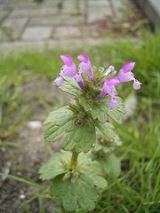
Lamium amplexicaule
Encyclopedia
Lamium amplexicaule is a species of Lamium
native to Europe
, western Asia
and northern Africa
.
It is a low-growing annual plant
growing to 10-25 cm tall, with soft, finely hairy stems. The leaves
are opposite, rounded, 2-3 cm diameter, with a lobed margin. The flower
s are pink to purple, 1.5-2 cm long.
It flowers very early in the spring even in northern areas, and for most of the winter and the early spring in warmer areas such as the Mediterranean region.
It propagates freely by seed
and is regarded as a minor weed
. Sometimes entire fields will be reddish-purple with its flowers before spring ploughing. Where common, is an important nectar and pollen
plant for bee
s, especially honeybees, where it helps start the spring buildup.
It is widely naturalised
in eastern North America
and elsewhere, where it is often considered to be an invasive weed. However, its edibility and readiness to grow in many climes often mean it is permitted to grow when other 'weeds' are not.
Lamium
Lamium is a genus of about 40-50 species of flowering plants in the family Lamiaceae, of which family it is the type genus...
native to Europe
Europe
Europe is, by convention, one of the world's seven continents. Comprising the westernmost peninsula of Eurasia, Europe is generally 'divided' from Asia to its east by the watershed divides of the Ural and Caucasus Mountains, the Ural River, the Caspian and Black Seas, and the waterways connecting...
, western Asia
Asia
Asia is the world's largest and most populous continent, located primarily in the eastern and northern hemispheres. It covers 8.7% of the Earth's total surface area and with approximately 3.879 billion people, it hosts 60% of the world's current human population...
and northern Africa
Africa
Africa is the world's second largest and second most populous continent, after Asia. At about 30.2 million km² including adjacent islands, it covers 6% of the Earth's total surface area and 20.4% of the total land area...
.
It is a low-growing annual plant
Annual plant
An annual plant is a plant that usually germinates, flowers, and dies in a year or season. True annuals will only live longer than a year if they are prevented from setting seed...
growing to 10-25 cm tall, with soft, finely hairy stems. The leaves
Leaf
A leaf is an organ of a vascular plant, as defined in botanical terms, and in particular in plant morphology. Foliage is a mass noun that refers to leaves as a feature of plants....
are opposite, rounded, 2-3 cm diameter, with a lobed margin. The flower
Flower
A flower, sometimes known as a bloom or blossom, is the reproductive structure found in flowering plants . The biological function of a flower is to effect reproduction, usually by providing a mechanism for the union of sperm with eggs...
s are pink to purple, 1.5-2 cm long.
It flowers very early in the spring even in northern areas, and for most of the winter and the early spring in warmer areas such as the Mediterranean region.
It propagates freely by seed
Seed
A seed is a small embryonic plant enclosed in a covering called the seed coat, usually with some stored food. It is the product of the ripened ovule of gymnosperm and angiosperm plants which occurs after fertilization and some growth within the mother plant...
and is regarded as a minor weed
Weed
A weed in a general sense is a plant that is considered by the user of the term to be a nuisance, and normally applied to unwanted plants in human-controlled settings, especially farm fields and gardens, but also lawns, parks, woods, and other areas. More specifically, the term is often used to...
. Sometimes entire fields will be reddish-purple with its flowers before spring ploughing. Where common, is an important nectar and pollen
Pollen
Pollen is a fine to coarse powder containing the microgametophytes of seed plants, which produce the male gametes . Pollen grains have a hard coat that protects the sperm cells during the process of their movement from the stamens to the pistil of flowering plants or from the male cone to the...
plant for bee
Bee
Bees are flying insects closely related to wasps and ants, and are known for their role in pollination and for producing honey and beeswax. Bees are a monophyletic lineage within the superfamily Apoidea, presently classified by the unranked taxon name Anthophila...
s, especially honeybees, where it helps start the spring buildup.
It is widely naturalised
Naturalisation (biology)
In biology, naturalisation is any process by which a non-native organism spreads into the wild and its reproduction is sufficient to maintain its population. Such populations are said to be naturalised....
in eastern North America
North America
North America is a continent wholly within the Northern Hemisphere and almost wholly within the Western Hemisphere. It is also considered a northern subcontinent of the Americas...
and elsewhere, where it is often considered to be an invasive weed. However, its edibility and readiness to grow in many climes often mean it is permitted to grow when other 'weeds' are not.

